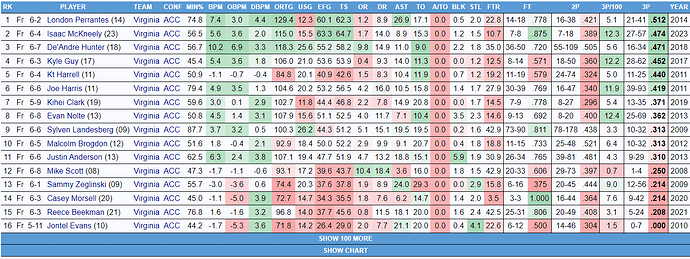Love the Joe comp. Feels better especially with some of the iso shot hunting we are starting to see from imac
McKneely is also an underrated rebounder.
He needs to hit the weights though.
He will. For the list of my UVA basketball concerns for the next 3 years Isaac McKneely adding muscle is not remotely on the radar lol
Imac relatively jacked for a first year I would say, no?
I’m sure it was mentioned in the game thread, but IMc’s blocked shot with about 3:00 left was HUGE. A State layup there would have cut into the lead enough to at least make it interesting but that pretty much deflated State. Like has been said here, he’s so much more than just a shooter.
Kid will be a UVa legend when he’s done.
IMac has pretty legit size for a first year especially as a guard. The size will come as he grows into his age and obviously training in a year round environment will help. But he’s coming from a good starting point much more so than most of the guards previously recruited. Casey is one of the few I remember being impressed with when he walked in the door, but it doesn’t happen often.
Agree, but obviously IMac is more athletic.
More on Mckneely: these are the stats of every UVA freshman (who played >40% of min) in Torvik’s database in conference play – sorted by 3pt percentage.
iMac is up there with the best of 'em
I am liking this Usage thing although not sure how it is calculated
Short version: it’s the percentage of a team’s offensive possessions that you are responsible for ending (or “using”), defined by attempting a shot, drawing a foul, or turning the ball over.
Long version: Usage and Efficiency | Squared Statistics: Understanding Basketball Analytics
- Calculation*
100*((FGA+0.44FTA+TO)(TMP/5))/(MP*(TFGA+0.44*TFTA+TTO))
Where FGA=Field-Goal Attempts, FTA=Free-Throw Attempts, TO=Turnovers, TMP=Team Minutes Played, MP=Minutes Played, TFGA=Team Field-Goal Attempts, TFTA=Team Free-Throw Attempts, TTO=Team Turnovers
2.Explanation*
This may be the most complicated looking calculation yet, but the concept behind it is really quite simple. Usage rate calculates what percentage of team plays a player was involved in while he was on the floor, provided that the play ends in one of the three true results: field-goal attempt, free-throw attempt or turnover.
On average, a player will have a usage rate of 20 percent. Think about it and it will make perfect sense.
3.Limitations*
Only the true outcomes are measured here, so there is quite a bit left out. For example, a player like Ricky Rubio, who prefers to pass more than shoot will have a much lower USG% than a player who prefers to shoot.
Yet, a player who passes the ball is still involved in a possession in my mind.
I’m guessing that if a player takes a shot, misses it, and then the team gets the OR… that shot did not “end the possession” and thus doesn’t count toward usage rate? Better yet, get to the line, make the first, miss the second, your teammate taps it in… did you just get 1 point with no usage?
KenPom measures just pure shot% (who took the shots) which is innaresting, too
I don’t think it’s that sophisticated.
What iMAC does individually has nothing to do with the rest of “Uva basketball concerns” lol. But since we are talking *specifically about iMAC then YES a concern should be that he does need to hit the weights.
It does. I was imprecise with my description. Usage rate is based on “scoring chances” not possessions, so you can have multiple scoring chances on a possession. In the second example, you are credited with 0.88 worth of usage (0.44 * 2 FTA).
Yeah I should have just read the formula. Lazy, just like my teachers always said.
If a point guard controls the game and makes 20 assists with no turnovers, does his usage = 0? And does a 0 usage = useless?
Use%: Usage Percentage estimates the percentage of team plays that used a player while they were on the floor.
